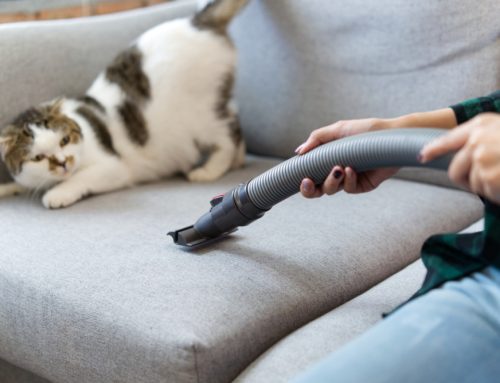The current “safer at home” measures have meant more time with our pets. Dogs are social and love to be with their pack/family. Cats and other pets have become accustomed to having us around more, too. When we transition back to school and work, our pets may feel that their world has been turned upside-down. The Billings Family Animal Hospital team wants to help you avoid any pitfalls as you leave your pets at home. Learn from the following stories, which describe the aftermath of severe separation anxiety in pets.
Roscoe’s panic
When Sally pulled into the driveway, the neighbor met her at the car. “I heard unusual noises today while you were at work. I finally realized it was Roscoe. I’ve never heard him cry, howl, and whine like that. Do you think he was having a panic attack?”
Sassy’s damage
Arriving home with the kids after school, George couldn’t believe his eyes. Couch cushions were destroyed, stuffing was everywhere, and the front door trim was damaged. When Sassy jumped in excitement, they were shocked to see her torn nails and bleeding paws.
Miss Kitty’s accident
When Rhonda came through the door after a long day back at work, she was greeted by a strong smell. Miss Kitty had never gone outside the litter box before, but there was the evidence—urine and feces on the living room rug.
Though Roscoe, Sassy, and Miss Kitty are fictional, their experiences are real for many pets. Sudden environmental changes can trigger pets’ fear of being alone. Separation anxiety signs in pets include excessive vocalization, extreme drooling, destructive behavior, house soiling, or continual pacing. Some pets may escape their enclosure, others may show aggression when the family leaves, and at the other end of the spectrum, some become lethargic or depressed.
Separation anxiety signs
Early signs of separation anxiety are hard to detect, since the behaviors occur while the family is gone. To detect early signs and prevent them from escalating, make gradual rather than sudden changes. For example, leave for short periods of time on several different days before the first long day, but be aware of individual differences, because more frequent departures can actually worsen the problem in some pets. When you return, closely check your pet and the environment for any problems; for example, what looks like water on the floor could be drool or urine. A pet with other behavior issues, such as storm phobia, may be more likely to develop separation anxiety. A video camera may help detect symptoms, but is not necessary for a diagnosis when you have other evidence.
Separation anxiety therapy

The overall goal of prevention and therapy of separation anxiety is to generate a feeling of predictability and security in your pet. Not only must the pet’s environment be managed, but also the family’s actions. For example, a safe crate and a treat puzzle with frozen peanut butter enriches the environment, preventing boredom. And the family can change their actions by keeping departure and arrival times low-key. Consider the following checklist:
- Do you avoid the trigger that starts the cascade of fear (e.g., picking up keys more quietly)?
- Can you hire a pet sitter to walk your pet during the day, being aware that some pets may feel worse when the sitter leaves?
- Have you cleaned accidents with an enzymatic odor eliminator?
- Would installing a doggie or kitty door help?
- Does your pet have a small, safe retreat, such as a crate, keeping in mind that some pets are more anxious when crated?
- Would calming music help, knowing that radio voices or a recording may be too stimulating?
- Could you leave an unwashed clothing article, so your scent may calm your pet?
- Do you know your pet’s favorite treat puzzle (e.g., homemade treat maze, treat-dropping ball, Kong with peanut butter)?
- Do you briefly acknowledge your pet on arrival, and wait to interact until they have settled down?
- Do you reward calm responses to triggers?
- When you are not leaving, do you perform triggers (e.g., picking up keys) to “desensitize” your pet, or “uncouple” these cues from anxiety?
- Do all family members know that punishment will only worsen the anxiety?
Medication can sometimes help, but must be combined with behavior therapy. Pet separation anxiety medications fall into one of three categories:
- Prescription medications — These medications, such as antidepressants or anti-anxiety medications, can calm or sedate your pet.
- Nutritional supplements — Supplements that may help are available as prescriptions and over-the-counter.
- Pheromone sprays — Sprays, wipes, collars, or diffusers work with the pet’s nervous and hormone systems to encourage a sense of well-being.
Our Billings Animal Family Hospital team will walk you through the process of determining which meds, or combinations of meds, will work best for your pet and your situation.
With help from our veterinary team, your pets do not have to suffer Roscoe, Sassy, and Miss Kitty’s experiences. The prognosis for your pet’s separation anxiety is good, because problem behaviors can usually be suppressed or reduced. As your family transitions to less time at home, call us at Billings Animal Family Hospital if you have questions about avoiding separation anxiety in your pet.








Leave A Comment